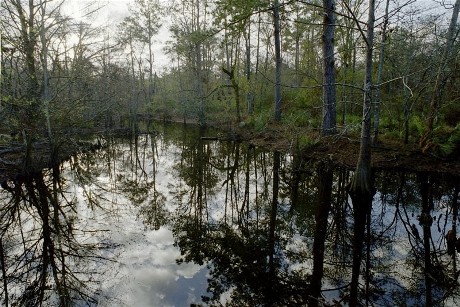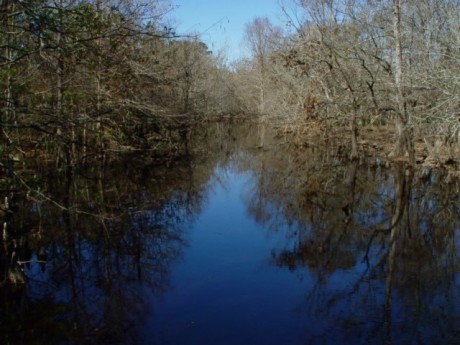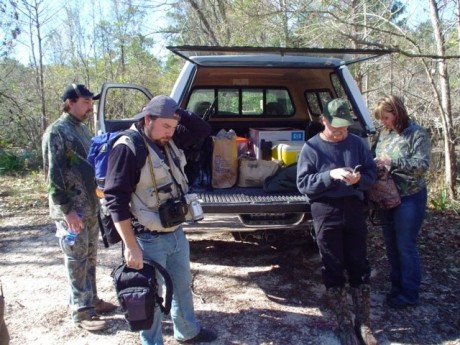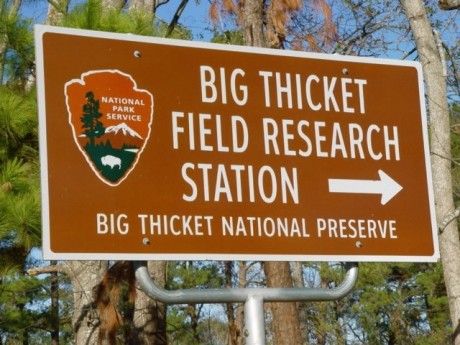Texas Bigfoot Research Operation
Posted by: Craig Woolheater on February 24th, 2007

Photographic credit: Chris Buntenbah
In recent discussions here on Cryptomundo, talk of how to conduct field research for Bigfoot has been an active topic. Cryptomundo reader DWA mentions our field operations at the TBRC quite frequently.
Posted to the blog How Would You Hunt Bigfoot?
My point about P/G wasn’t intended to slight anybody – the TBRC in particular. I’m as avid a reader of their expedition reports as anybody. If somebody well funded by a big donor to look into this had been on any of the trips they’ve put up on their site, we’d be getting the time and money we need for sas confirmation. We’d very possibly know by now. One hopes. But based on the evidence I think it’s more than a slim chance.
But just when the TBRC has something really compelling happen – frequently the latest in a series of really compelling somethings – everybody’s got to go back to work. It’s got to be pretty frustrating (although having those experiences must count for some compensation). Patterson was equipped to stay out and resupply if he needed to for as long as it took. And it took longer than any amateur organization, doing it for the love not the money, has to spend in the field. TBRC seems to have LOTS of good stuff, and the savvy to use it right. There’s a lot happening on those trips that there’s just no easy explanation for, and the hoax one looks most unlikely.
But there’s just not the time. The time seems the biggest issue.
I’ve seen the Relic Follies go on for half a century without results. The problem is what people AREN’T looking for. Other than a few folks with the gear, the know-how…and a job to return to Monday. (And three of the people on the TBRC’s latest posted expedition were biologists.)
What could possibly be more scientific than looking at sighting patterns; noting in what kind of places the sightings happen; seeing that those places correspond to excellent habitat; then going there prepared to document?
The TBRC knows. That’s the essence of science.DWA
February 16, 2007

Posted to the blog Update: The Foot of Bigfoot?
As much as I enjoy reading about the TBRC’s exploits, maybe the passive, game-camera/pherie trap approach is better (and the TBRC seems to be rethinking the pursuit scenario and going more for game cameras).
One thing the TBRC can’t do, though, is a long-term stay. That is a sizable reason why they do it in pursuit mode; they have only three days to get evidence. A team staying long term can try a mix of techniques on different days in different areas with different conditions.DWA
February 22, 2007

2006 was a busy year for the persistent and determined TBRC (the non-profit Texas Bigfoot Research Conservancy, formerly the Texas Bigfoot Research Center). The TBRC kicked off 2006 with Operation Thicket Probe II, returning to an area that seemed to hold promise, based on field observations made in 2005. Read the recently published report for the TBRC’s Operation Thicket Probe II, and keep a watch for the TBRC’s initial report on Operation Forest Vigil over the next few weeks, further detailing their ongoing and projected long-term research efforts in Texas, Oklahoma, Arkansas and Louisiana.

Read about the TBRC’s Operation Thicket Probe here on Cryptomundo.
About Craig Woolheater
Co-founder of Cryptomundo in 2005.
I have appeared in or contributed to the following TV programs, documentaries and films:
OLN's Mysterious Encounters: "Caddo Critter", Southern Fried Bigfoot, Travel Channel's Weird Travels: "Bigfoot", History Channel's MonsterQuest: "Swamp Stalker", The Wild Man of the Navidad, Destination America's Monsters and Mysteries in America: Texas Terror - Lake Worth Monster, Animal Planet's Finding Bigfoot: Return to Boggy Creek and Beast of the Bayou.









I am curious, what type of cooperation or resistance does the TBRC get from the National Park Service?
Or benign neglect?
The various TBRC reports address your question. As stated in the Thicket Probe II writeup, “all projected research activities were cleared through proper Big Thicket National Preserve channels; the appropriate scientific research permit was acquired, as were camping permits for any overnight stays along the Neches River.”
I am pleased to see that there will be some attempt to have a longer field expedition done. I feel the lack of time that is able to be committed to the investigation has always been the problem with field work in the past and I agree with DWA that absolutely a team that is there for the long haul will be able to try different techniques in different areas. Sure, people come across Bigfoot without staying out in the field for days, but these are typically chance occurrences and these encounters typically happen to those that are not equipped or mentally prepared for what they see. The field expeditions for Bigfoot have been frustrating in that they typically do not have this kind of fortune and when it seems they are close to something major, they are unable to continue the expedition due to lack of funds and time. Any research team out studying a known animal would need the advantage of having the needed time to appropriately document what they are out to find and so with such an apparently rare and elusive creature as Bigfoot, this is going to be all the more important. The three day pursuits of Bigfoot are obviously not working in that, as DWA so rightly says, it has been half a century of pursuit without definitive success. If Bigfoot investigations are to be scientifically conclusive, then it is time they start devoting the time and resources needed to at least approach the kind given to expeditions for mainstream animals. Perhaps it is time to change the methods involved here and I think this article mentions what to me is a good start.
Bigfoot can’t be driven by man or helicopter, contrary to the believe of the federal government. Remote trail cams have a history of failure, due to Bigfoot telepathic ability to know when and where the researcher is planting the camera, and that pesky old 4th dimensional thing. Bigfoot is alerted to people wearing camo. Bigfoot is alerted to large groups of men in the woods. Two women out of a large group of men, is insufficient numbers to gain cooperation with the Bigfoot. Whispering in order to keep Bigfoot from hearing them, is completely ineffective at accomplishing said task. Other than that, the TBRC isn’t doing a thing wrong and apparently put together a terrific bonding experience.
Sorry to take the minority view here, but an intelligent (and how can we say otherwise) quarry that can detect humans at a distance will never be detected because they will never venture into range. Almost every credible report has the creatures appearing surprised or annoyed. Occasionally there are other sightings of youngsters or curious creatures, but on the whole sightings are rare, unusual and brief. Often the creatures will withdraw (Sasquatch), rarely they will charge (bigfoot) first.
I have met some pilots at a local airport that fly helicopters for logging and they say they see Sasquatch all the time. As hearsay I am told this is borne out by Sherriff’s Department and Border Patrol pilots.The creatures seem to regard helicopters as a non-threatening, though interesting phenomena. This may be the way to go. I really think that we will discover these creatures in some unusual way. As an example, a bear recently was reported by a spooked homeowner in North Vancouver. The bear was sitting (I am not making this up!) at the kitchen counter, eating a berry pie and a pound of butter. The homeowner tried to shoo it away, but the bear wouldn’t go before finishing. A week later a bear walks into a nearby Safeway and makes his way toward the bakery. True story! I expect that is a more likely scenario than actually tracking down one of these creatures in the bush.
Buzzardeater said:
“Sorry to take the minority view here, but an intelligent (and how can we say otherwise) quarry that can detect humans at a distance will never be detected because they will never venture into range.”
Well, according to TBRC’s report, if what they saw on the last night was a bigfoot, it definitely had ventured “into range.” CLOSE range. Those two guys said it was about 10-15 yards away (30-45 feet). Man, THAT is close. It sounds like this thing may have been confused as to what exactly was taking place out there. Those guys were playing all kinds of strange primate sounds, and maybe its curiosity nearly got the better of it.
I don’t think the TBRC cared that it detected them. I think their point was just to try to get it in a scenario where it could be filmed or photographed. It sounds like they may have had that opportunity for perhaps 5 – 10 seconds, and for whatever reason were unable to capitalize on it.
mystery_man said:
“Sure, people come across Bigfoot without staying out in the field for days, but these are typically chance occurrences and these encounters typically happen to those that are not equipped or mentally prepared for what they see.”
Mystery_man, NOBODY can be prepared mentally for an encounter with these things! They’re not supposed to exist!
It sounds to me that these were not “chance” occurrences, but may have been somewhat facilitated by TBRC’s persistence and methods, IF that’s what they encountered (although there has to be a measure of chance or luck involved); it sounds like it IS what they encountered to me, not just this time, but the last time they were in the area.
I think it comes down to time and finances, just like DWA said in the quotes above. I agree with DWA that TBRC, if properly funded and supported, could hit paydirt over a period of time. Maybe with their new non-profit status, that funding could be in the future. Who knows? Let’s keep our fingers crossed.
I may have posted enough on this thread. But let’s put something up in basic black. 😀
I’ve said it before on other threads. These animals – anecdotally – remind me of bighorn sheep: extreme aversion to close contact with humans, combined with an insatiable curiosity about us that can’t help but get the better of them sometimes. Reading TBRC reports, their teams have considerable contact (unfortunately none of it conducive to photography, yet) with something that sure doesn’t seem like anything else in Texas.
I’ve also mentioned those (Bobbie Short a prominent one) who say that expeditions like TBRC’s are a waste of time. Well, they sure don’t read like a waste to me. Again, I bring up George Schaller and Jane Goodall. Given what they say about sas and yeti just from what they’ve read…what do you think they’d say if they’d been near those backpacks on that right-of-way?
As Alton Higgins pointed out in his after-action, people who aren’t there can chalk much of this alleged contact up to anticipation and nerves, and reading stuff in that isn’t there. Well, yeah. But they weren’t there.
I can’t bring myself to call this kind of work harrassment. I think of it as more an effort to make contact, and give the animal room to decline. (I don’t believe any sas would let you get within 30 feet at night if it didn’t want to be there. And I also have to say I would have flooded that big shadow with a white light, and that not doing so took restraint that might pay dividends later.) Now darting and collaring…well, for all it’s taught us, you don’t have to twist my arm to get me to think that crosses a line. We should be trying to do it differently, and the technology is there to do it differently.
What I like about TBRC is that they’re trying to start a conversation. Maybe with an animal that, with all the reason we give it for caution, might be hoping we’re ready for one.
Sergio, i guess you are right about nobody being prepared to see them, but I think you miss my point. A hiker out in the woods who suddenly comes across a Bigfoot is going to be a great deal less mentally prepared than a group of people out looking for Bigfoot, who have studied it and are hoping to see it, don’t you think? This is the same for known animals. If you are out camping and come across a grizzly, well you are going to be a lot more taken aback by it than if you are out studying grizzlies. Bigfoot may not be proven to exist yet, but it is still an animal all the same and trained professionals who are trying to study it are going to be a great more prepared when they come across it. At least more so than the average Joe. That’s my gist.
And I don’t agree with Sergio when he says “They are not supposed to exist.” Really? I think not being proven to exist yet is different from “not supposed to exist.” For these people out searching, there is every possibility that it exists.
silvereagle: the reports seem to show the sas walking a very thin tightrope between evasion and discovery with the TBRC.
If, instead, they’re staying away, well, somebody needs to tell me what other species of unknown animal is out there. Maybe the ivorybill is getting tired of our failure to find him.
DWA, And consistently walking that thin tight rope would tend to indicate high intelligence, don’t cha think?
silvereagle:
High intelligence? You gotta be kidding me. This guy makes anything else in North America look, well, distinctly in need of a degree. (Including, sometimes, us.) This is why I don’t consider the lack of photo evidence or hunter kills or road kills to be convincing. Not only can we not be sure those things haven’t happened, with an attendant shovel-and-shut-up; the putative intelligence of the animal (combined of course with what I think we can presume is its rarity) is, to me, good reason to presume that if it has happened it sure is a rare occurrence.
Guess my point is that this guy doesn’t need, in my opinion, any special – as in, fourth-dimensional or telepathic – abilities to avoid science. All he needs is science’s refusal to seriously look, combined with the extreme smarts, omnivory and readiness to move, far and fast, to generally avoid enough of the rest of us to keep science comfortably ignorant.
As I’ve pointed out elsewhere, First Nations people had seen, by the time of first European settlement, far more wildlife than Europeans ever will. So they’ve observed the full range of animals’ behavior. Shoot, if the sas is a four-dimension telepath I’ll be the first to eat my hat. (Horseradish sauce.) It’s just that science isn’t in a place to document that yet.
The big guy – as I actually said above – may just be feeling us out, seeing if we’re ready for that talk.
Smart? Oh hell yeah. Culture, jet planes, automobiles, etc? So where are those, you ask? Hey, like I said. He’s SMART. Maybe he thought about it, and Just Said No.
Gotta have an open mind on these things. 😉
If they ever go to Honey Island to look, I want to go with them.